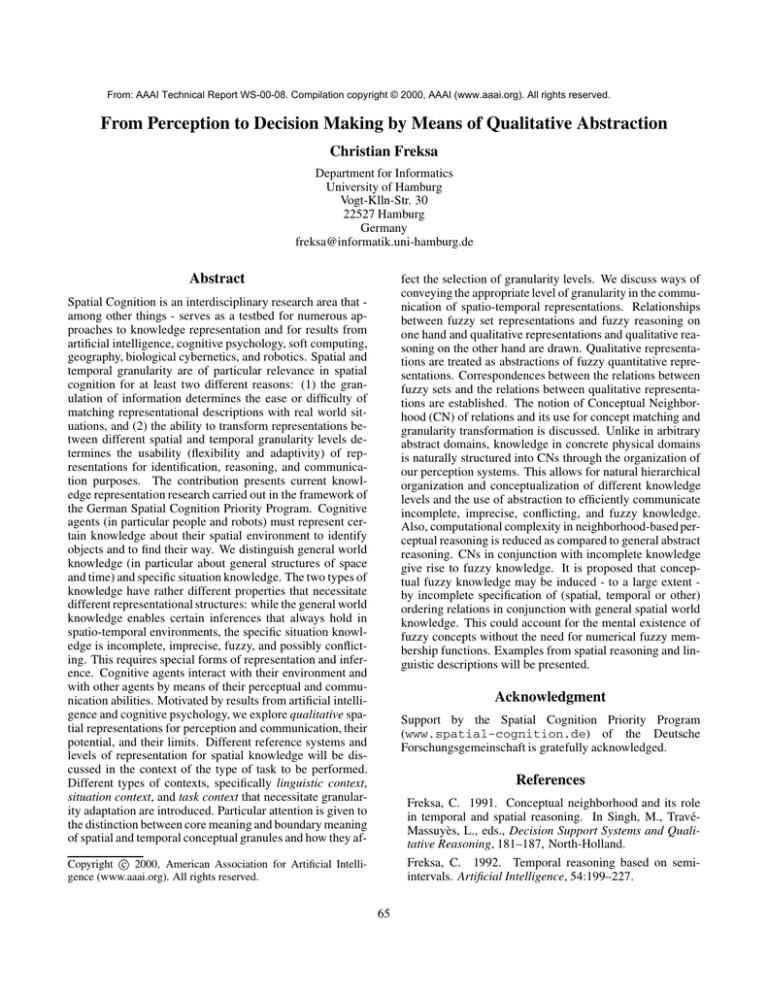
From: AAAI Technical Report WS-00-08. Compilation copyright © 2000, AAAI (www.aaai.org). All rights reserved.
From Perception to Decision Making by Means of Qualitative Abstraction
Christian Freksa
Department for Informatics
University of Hamburg
Vogt-Klln-Str. 30
22527 Hamburg
Germany
freksa@informatik.uni-hamburg.de
Abstract
fect the selection of granularity levels. We discuss ways of
conveying the appropriate level of granularity in the communication of spatio-temporal representations. Relationships
between fuzzy set representations and fuzzy reasoning on
one hand and qualitative representations and qualitative reasoning on the other hand are drawn. Qualitative representations are treated as abstractions of fuzzy quantitative representations. Correspondences between the relations between
fuzzy sets and the relations between qualitative representations are established. The notion of Conceptual Neighborhood (CN) of relations and its use for concept matching and
granularity transformation is discussed. Unlike in arbitrary
abstract domains, knowledge in concrete physical domains
is naturally structured into CNs through the organization of
our perception systems. This allows for natural hierarchical
organization and conceptualization of different knowledge
levels and the use of abstraction to efficiently communicate
incomplete, imprecise, conflicting, and fuzzy knowledge.
Also, computational complexity in neighborhood-based perceptual reasoning is reduced as compared to general abstract
reasoning. CNs in conjunction with incomplete knowledge
give rise to fuzzy knowledge. It is proposed that conceptual fuzzy knowledge may be induced - to a large extent by incomplete specification of (spatial, temporal or other)
ordering relations in conjunction with general spatial world
knowledge. This could account for the mental existence of
fuzzy concepts without the need for numerical fuzzy membership functions. Examples from spatial reasoning and linguistic descriptions will be presented.
Spatial Cognition is an interdisciplinary research area that among other things - serves as a testbed for numerous approaches to knowledge representation and for results from
artificial intelligence, cognitive psychology, soft computing,
geography, biological cybernetics, and robotics. Spatial and
temporal granularity are of particular relevance in spatial
cognition for at least two different reasons: (1) the granulation of information determines the ease or difficulty of
matching representational descriptions with real world situations, and (2) the ability to transform representations between different spatial and temporal granularity levels determines the usability (flexibility and adaptivity) of representations for identification, reasoning, and communication purposes. The contribution presents current knowledge representation research carried out in the framework of
the German Spatial Cognition Priority Program. Cognitive
agents (in particular people and robots) must represent certain knowledge about their spatial environment to identify
objects and to find their way. We distinguish general world
knowledge (in particular about general structures of space
and time) and specific situation knowledge. The two types of
knowledge have rather different properties that necessitate
different representational structures: while the general world
knowledge enables certain inferences that always hold in
spatio-temporal environments, the specific situation knowledge is incomplete, imprecise, fuzzy, and possibly conflicting. This requires special forms of representation and inference. Cognitive agents interact with their environment and
with other agents by means of their perceptual and communication abilities. Motivated by results from artificial intelligence and cognitive psychology, we explore qualitative spatial representations for perception and communication, their
potential, and their limits. Different reference systems and
levels of representation for spatial knowledge will be discussed in the context of the type of task to be performed.
Different types of contexts, specifically linguistic context,
situation context, and task context that necessitate granularity adaptation are introduced. Particular attention is given to
the distinction between core meaning and boundary meaning
of spatial and temporal conceptual granules and how they af-
Acknowledgment
Support by the Spatial Cognition Priority Program
(www.spatial-cognition.de) of the Deutsche
Forschungsgemeinschaft is gratefully acknowledged.
References
Freksa, C. 1991. Conceptual neighborhood and its role
in temporal and spatial reasoning. In Singh, M., TravéMassuyès, L., eds., Decision Support Systems and Qualitative Reasoning, 181–187, North-Holland.
Freksa, C. 1992. Temporal reasoning based on semiintervals. Artificial Intelligence, 54:199–227.
­
Copyright c 2000, American Association for Artificial Intelligence (www.aaai.org). All rights reserved.
65
Freksa, C. 1994. Fuzzy systems in AI. In Kruse, R., Gebhardt, J., Palm, R., eds., Fuzzy systems in computer science,
Series: Artificial Intelligence, Braunschweig/Wiesbaden:
Vieweg 1994.
Freksa, C. 1994. Fuzzy logic: an interface between logic
and human reasoning. IEEE Expert, 9(4):20–21.
Freksa, C., Barkowsky, T. 1996. On the relation between
spatial concepts and geographic objects. In Burrough,
P., Frank, A. eds, Geographic objects with indeterminate
boundaries, 109–121, Taylor and Francis, London.
Freksa, C. 1999. Spatial aspects of task-specific wayfinding maps. In Gero, J.S., Tversky, B., eds, Visual and Spatial
Reasoning in Design: A representation-theoretic perspective, 15–32, Key Centre of Design Computing and Cognition, University of Sydney.
Zadeh, L.A. 1979. Fuzzy sets and information granularity.
In M. Gupta, R. Ragade and R. Yager, eds., Advances in
Fuzzy Set Theory and Applications, 3–18, North-Holland.
Zadeh, L.A. 1997. Toward a Theory of Fuzzy Information Granulation and its Centrality in Human Reasoning
and Fuzzy Logic.
Zadeh, L.A. 1999. From Computing with Numbers to
Computing with Words – From Manipulation of Measurements to Manipulation of Perceptions. IEEE Transactions
on Circuits and Systems, 45:105–119.
66


